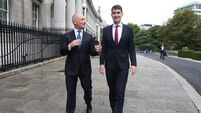NTMA bond sale raises €3.75bn
There was huge demand for the issue with final bids in excess of €14bn from a mix of 400 investors. The success of the first 10-year bond issue since exiting the bailout last month helped push yields on Irish 10-year debt down to an eight-year low. “We are now trading as an investment grade credit rating notwithstanding the Moody’s rating,” said John Corrigan, the NTMA chief executive.
Moody’s is the only remaining major credit rating agency to have Ireland on junk status.
Mr Corrigan declined to speculate on when Moody’s might upgrade the rating, although he noted that it was “softening its stance on the eurozone”.
Only 17% of the bids came from Irish investors with the balance coming from international funds.
Of these 26% were from the UK; 15% were from the Nordic countries; 15% from north America; 14% from Germany, Austria, and Switzerland; 7% from the rest of Europe, and a “smidgeon” from the Middle East, said Mr Corrigan.
Moreover, most were real money investors such as pension funds, insurance funds, and central banks. Only 8% of the final allocation went to hedge funds, he added.
The NTMA ended last year with €18.5bn in cash balances, however, it has to redeem a €2.8bn bond that matures next week. Mr Corrigan said the overall target for this year would be to raise roughly €8bn. Even though it could have raised the full amount yesterday, this would have been a negative for investors because it would hamper liquidity and price formation, he added.
The economy is now fully funded into 2015 but there are some lumpy bond maturities lurking over the next few years.
The NTMA will now look to topslice a €10bn bond set to mature in Apr 2016 by potentially swapping some of it into the bond issued yesterday, among other options, said Mr Corrigan.
Finance Minister Michael Noonan said: “This sale “shows that Ireland has fully exited the EU/IMF programme of assistance.
“The yield of 3.54% illustrates the strength of Ireland’s international reputation and brings us far closer to the borrowing rates of the strongest European economies. I would like to acknowledge that strong investor sentiment was built through a series of transactions announced in November and December that coincided with exit from the EU-IMF programme.















